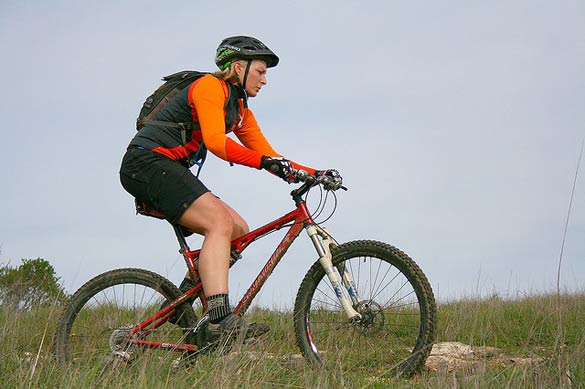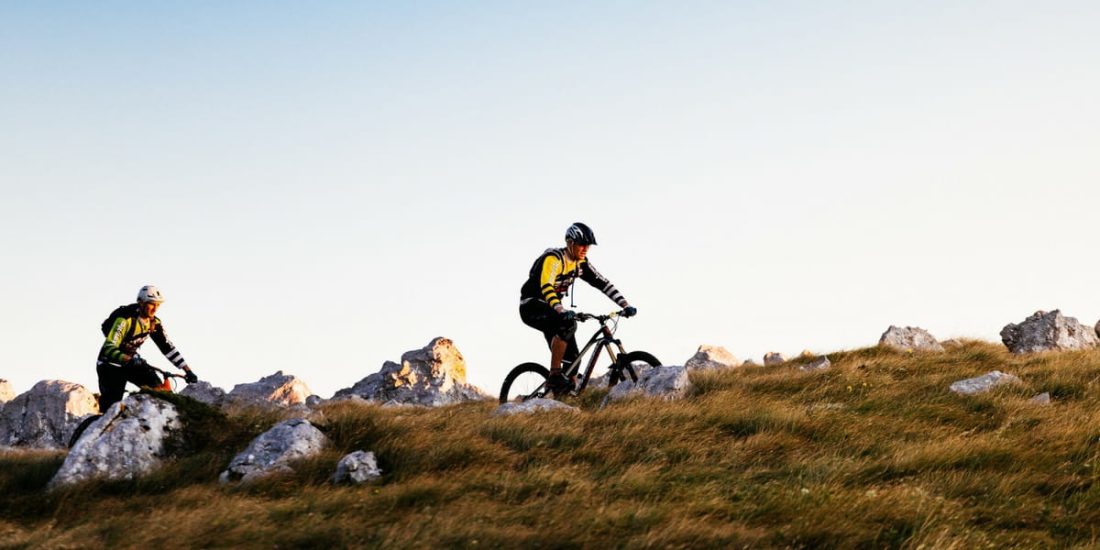
How to get better and suffer less mountain biking while climbing
Content
How to suffer less on the hills on mountain bikes: this is the question that most mountain bikers ask themselves. Either because they want to increase their dose of pleasure while hiking, or because they need performance to achieve a specific goal, such as a race or a raid.
We'll see what mechanically comes into play when a mountain biker approaches a hill, classify the different types of climbs, and then determine what workouts need to be done to improve.
Theory: what is the impact of mountain biking
A little physics, not too much, I promise.
The elementary physics we study in high school helps us find important points for more efficient mountain biking uphill.
The power-to-weight ratio of a rider is the dominant factor in how quickly a rider can climb.
From a mechanical point of view, several forces impede the movement of the cyclist.
Displacement lifting forces:
- Gravity: When climbing, this vertical force slows down the cyclist's movement. It is the force that most strongly opposes uphill movement.
- Frictional Force: This is the resistance parallel to the slope, but its effect is not very interesting for the rest of our study.
- Aerodynamic drag: related to the speed of travel, this force will decrease significantly on ascent as the speed decreases.
Note: There is another force, ground resistance. It is perpendicular to the ground and is applied to the ground contact points, which are the wheels of an ATV.
But there is only one major force we try to overcome when climbing: gravity.  Force = mass x acceleration = mass x gravity
Force = mass x acceleration = mass x gravity
Note. The weight of your bike and everything else is included in the total weight, so it is more difficult to climb on a 20 kg bike than on a 15 kg mountain bike.
As we climb a hill, the component of gravity tries to pull us back down the hill. Without going into the details of geometry, the steeper the slope, the more the gravitational component pulls us down and the more force our legs have to apply to overcome it.
There are small frictional forces between the tires and the ground, called rolling resistance, and also in the wheel hub bearings of a bicycle, but these are very small compared to gravity. When the slope of the hill becomes zero, we are on the flat side, and no gravity component is trying to hold us.
On a flat surface, you mostly struggle with wind resistance, which is caused by your own movement, and the higher your speed, the stronger the wind resistance.
Since the climb occurs at a rather low speed, the wind resistance is negligible. So, on a flat surface, the rider's power is the deciding factor, not his weight. A stronger rider will be faster on level ground, even if he is heavy.
To go (much) further, go to VéloMath
So, to move effectively uphill, you must:
- influential
- World
Different types of ascents
To climb hills, three types must be distinguished:
Long coast

It takes endurance. You will need to adapt your speed, not just start the easiest development right away, but take a regular rhythm at the right pace. To do this, always look at least two meters in front of you to identify obstacles and correct trajectory. For more power, sit on the nose of the saddle and remain in the scabbard to maintain a straight trajectory, with your arms slightly bent inward and shoulders down. If your legs become too heavy, switch to a dance pose.
Steep slopes
These are slopes with a percentage of more than 20%.
Avoid the dancer anyway, this can lead to loss of grip.
Sit as far away from the saddle as possible (saddle nose) and bump into the bike (stem nose) with your elbows tilted down. Put in a small gear and follow your normal pedaling rhythm. Keep your bike well grouped and lower your torso as the incline becomes steep.
If this turns out to be too technically difficult, try picking the ball with slightly raised buttocks, as is the case with long ribs.
Do not form one body with your mountain bike (leave it free between your legs) to always support both wheels.
Technical Updates

Here, in addition to the percentage, the context is complicated by the state of the earth. This type of climb goes through bad terrain with rocks, obstacles, steps, roots. The floor is the exact opposite of smooth. The challenge is to keep the trajectory and enough grip to pass.
In this type of climb, the pace sometimes changes, and you need to adapt to the terrain, find the right gear, the right speed and the right grip, while maintaining balance on the mountain bike: the pedal travel should be smooth, the swing makes it easier to overcome obstacles, because there cannot be speech about passing by force.
- expectation is the keyword
- the pass must be made without stepping on the ground
- driving in the cleanest possible place saves energy and maintains traction
To overcome the obstacle:
- never stop pedaling
- lighten the front wheel when crossing, having already gone back
- when the wheel has passed, return to normal position and continue pedaling to move the rear wheel (help by shifting the weight to the front)
Alternate dancing and sitting depending on the steepness of the slope, allowing the mountain bike to move freely between your legs (do not form one body with the bike).
How to progress?
When climbing, the cadence will be lower than on a level surface. Using a larger sweep while keeping your cadence consistent with your condition may allow you to climb faster. To do this, you need to work on explosiveness. Heart rate and oxygen consumption are also more important, so you have to get your body used to this type of stress by working at greater intensity through increased endurance.
To progress in the hills, you will need to do certain exercises to build muscle and be effective over time.

There are 3 important points to be worked out:
endurance
Endurance corresponds to the ability to withstand physical and mental overwork and suffering. Physiologists talk about the ability to sustain efforts at an intensity less than or equal to 65% of VO2 max, or maximum oxygen volume, for as long as possible. We can define endurance more simply by saying that it is the ability to perform an activity at a moderate or reasonable pace and for a fairly long period of time without any decrease in performance.
In order to travel far and long, it is necessary to have sufficient reserves and the ability to use these reserves effectively. It's about aerobic work. Endurance training is performed at a heart rate between 60% and 80% of your maximum heart rate. However, as a general rule for all forms of basic endurance training, the heart rate rarely exceeds 150 beats per minute. Performance isn't really the goal, so you need to ride longer, increasing distance and being able to endure the repetition of short and tiring climbs.
You must be “fatigued” enough to optimize your aerobic capacity. Anyone on a bicycle can travel considerable distances at a moderate speed.
So ride long hours to increase your endurance!
Taking long walks on a regular basis will allow you to:
- optimize the use of fat reserves as an energy source
- improve your glycogen stores, especially in your muscles.
- train your muscles to the limitations of pedaling.
- learn how to effectively manage central fatigue (motivation, concentration, etc.).
- regulate body temperature more accurately
A Few Tips for Increasing Endurance
- Choose a reamer “too small” as often as possible: winding is better than pulling large gears.
- The cadence is the determining factor: at 80 rpm, the small chainring cannot do the same work as the same cadence on the large chainring.
- Avoid big falls, very fragile parts and all mountain biking difficulties that require explosive strength, work on your heart rate according to your age: 60% of your maximum heart rate.
In addition to cycling, jogging, swimming, and exercise bikes are sports that will help you improve your endurance.

Explosive strength - power
To work only on explosive ability, it is important to make short efforts (less than 6 seconds) and maintain a long recovery between each sprint (> 4 minutes).
Here are some suggested activities:
Cadence
Perform an exercise between 1:30 and 2:30 in which you perform the cadence pedaling exercise on flat or hilly terrain.
Pedal 60 rpm for 5 minutes with a gear large enough to work the muscles, then relax on easy development to reach 120 rpm for 5 minutes (but no twisting).
Repeat this sequence 3 times in a row and repeat 15 minutes after recovery.
Sprint courts
1:30 excursion with:
- 15 min warm-up
- alternate 12 times:
- 1 sprint 6 sec
- 5 min recovery
- return to calm
2:15 excursion with:
- 15 min warm-up
- Alternate 2 sets of 6 times (one set per hour, endurance riding the rest of the time):
- 1 sprint 6 sec
- 4 min recovery]
- return to calm
During this workout, it is very interesting to vary the type of sprint, changing the equipment (flexible, perfect or large), the type of start (stopped or started) and the position (like a dancer or staying seated throughout the sprint). ...
Long Sprints and Sprint Sequence
In addition to working on explosiveness, you can train your body to do anaerobic work, which will produce lactic acid. For this, long sprints or incomplete recovery between short sprints should be preferred.
1:30 excursion with:
- 20 min warm-up
- Alternate 3 sets of 5 times with a 15 minute recovery between the two.
- 1 sprint lasting 6 seconds
- 1 min recovery
- return to calm
1:30 excursion with:
- 20 min warm-up
- Alternate 6 times:
- 1 sprint lasting 30 seconds
- Recovery from 5 to 10 minutes
- return to calm
And without mountain biking?
If you don't have access to a bike, you can still train your strength with exercise at home.
Le squat jump
In a bent position (knee at a 90 degree angle), you push upward as much as possible (hands on hips).
You can repeat this movement several times in a row (5 to 10 times).
The drop jump:
Jump from a certain height and then bounce straight off the ground for maximum vertical thrust.
This movement is more muscular and is not recommended for use when approaching a target.
As with the squat jump, you can repeat the jump several times in a row (5 to 10 times).
You can also squat, jump rope, or quickly climb stairs.
The weight
Perhaps one of the main points. you should find your healthy weight and try to put on those extra pounds. See this article
And do not forget, the lighter you are, the faster you go, the more pleasant it will be!
Conclusion
By doing these exercises, you will be more efficient in your climbs and will enjoy mountain biking in hilly terrain. Always remember about pleasure and set a goal!
For a workout plan, check out the VO2 Cycling website.
